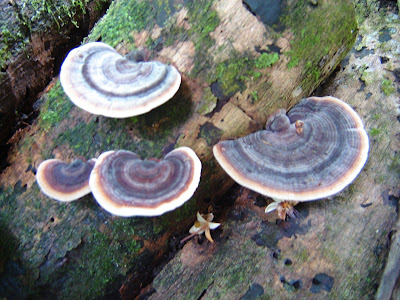It's supposed to be edible, when in this early stage. But, anything called an orange-netted stinkhorn is not something I want to put in my mouth. Especially with a notation in Mushrooms of Hawaii that reads: "Odor strongly fetid." I do want to cultivate some known, tasty, edible mushrooms, since my great shitake experiment was a total failure. Not one of the little plugs produced anything. However, I did read today (whilst trying to identify some of these) that oyster mushrooms are the easiest to cultivate.....so......we shall try.
Now this one is harder to identify. I'm working on it. Indoors, we can do a spore print, look at the gills and annulus or lack of, etc. There are some little nibbles out of one. Apparently the snails think it's tasty. Even with the book, I'm not sure here.
Another odd fellow. He's a sort of a black coral guy. Can't find him in either of my books, but for now will call it Black Coral Fungus. The photo doesn't really do them justice. They are definitely black, with lighter tips, but I need a better camera, looks like. If any of you can identify this sort, leave a comment. Growing in mulch under a Wi Apple seedling.
These are the mushrooms that did grow, on the logs into which I carefully stuck shitake plugs. Turkey-tail Polypore. Very seasonal. They are beautiful, as a bright side to the story. And a variety now known to be an immune system enhancer. Has been used in China to treat various types of cancer. The little fallen blossoms are cacao.
This one had a greenish spore print, so I'm pretty sure it is a Green-spored Parasol, or Chlorphyllum molybdites. We won't be eating any, as they tend to make people really really sick. The conclusion to this discussion might be, don't eat anything that could be confused with something else, that is not edible. Stick to the obvious. Like say Morels, Sulphur Shelf (also known as Chicken of the Wood), or Oyster mushrooms.
I really love checking out mushrooms. These were all around our gardens, trees and lawn. And, this seems to be the season.
According to mycologist and author of Mycelium Running, How Mushrooms Can Help Save the World, Paul Stamets, mushrooms have the unique ability to change an environment, and that we can utilize their digestive power to decompose toxic wastes and pollutants, catch and reduce silt from streambeds and pathogens from agricultural watersheds, control insect populations, and to generally enhance forest and garden health. God with great wisdom, has created in the fungi of this world an amazing clean-up tool, ever at work in their host environments, and able to be used with purpose where needed.
As Stamets says: "I believe that mycelium is the neurological network of nature. Interlacing mosiacs of mycelium infuse habitats with information-sharing membranes. These membranes are aware, react to change, and collectively have the long-term health of the host environment in mind. The mycelium stays in constant molecular communication with its environment, devising diverse enzymatic and chemical responses to complex challenges. These networks not only survive, but sometimes expand to thousands of acres in size, achieving the greatest mass of any individual organism on this planet....
These fungal fabrics run through the top few inches of virtually all landmasses that support life, sharing the soil with legions of other organisms. If you were a tiny organism in a forest's soil, you would be enmeshed in a carnival of activity, with mycelium constantly moving through subterranean landscapes like cellular waves, through dancing bacteria and swimming protozoa with nematodes racing like whales through a microcosmic sea of life.
Year-round, fungi decompose and recycle plant debris, filter microbes and sediments from runoff, and restore soil. In the end, life-sustaining soil is created from debris, particularly dead wood. We are now entering a time when mycofilters of select mushroom species can be constructed to destroy toxic waste and prevent disease..."The guy is amazing. He moves from observation to poetical digression, and has been called a "visionary emissary from the fungus kingdom to our world." Some of the book needs to be taken with a few grains of salt, not to mention light. God being the even more amazing, great Designer and Creator of our world with its magnificent ecosystem. I am in awe.
.








5 comments:
Wow, those are some unique and beautiful mushrooms.
Wow! That first lacey one is so pretty...doesn't look like it's actually a real mushroom...like it's made from sugar! And the rainbow ones...gorgeous! How fun to find so many different types :D
I'm no good at identifying mushrooms. I wish I was, because they're awfully delicious and I'm all for free food!
We forage for morels in the spring. Which that first photo has an uncanny resemblance to. Other than it's weird netted skirt. But the brain top is spot on.
Lovely photos!
♥ Rebecca Jean
Midnight Maniac
I do not like mushrooms but those are some way cool photos! Thanks!
Whoa these are awesome! They do look like pieces of artwork instead of fungi!
Post a Comment